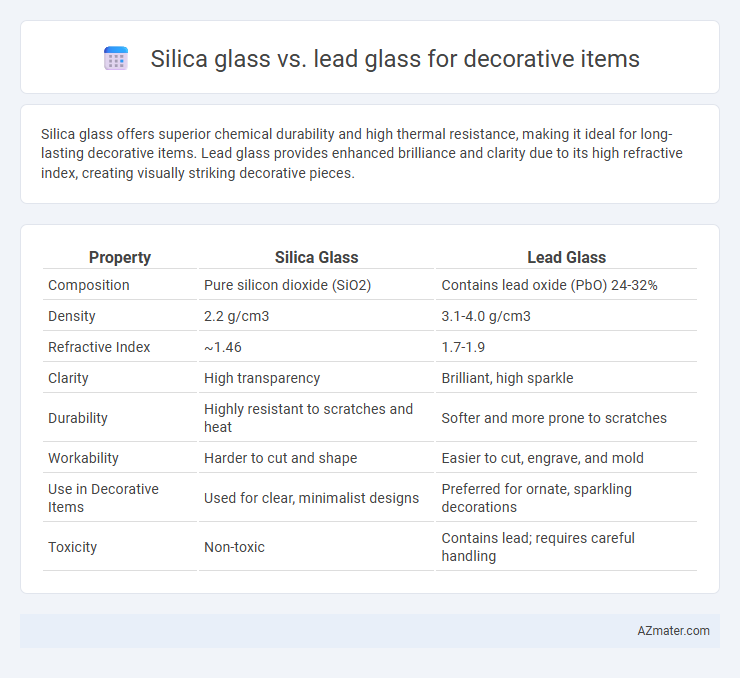Silica glass offers superior chemical durability and high thermal resistance, making it ideal for long-lasting decorative items. Lead glass provides enhanced brilliance and clarity due to its high refractive index, creating visually striking decorative pieces.
Table of Comparison
| Property | Silica Glass | Lead Glass |
|---|---|---|
| Composition | Pure silicon dioxide (SiO2) | Contains lead oxide (PbO) 24-32% |
| Density | 2.2 g/cm3 | 3.1-4.0 g/cm3 |
| Refractive Index | ~1.46 | 1.7-1.9 |
| Clarity | High transparency | Brilliant, high sparkle |
| Durability | Highly resistant to scratches and heat | Softer and more prone to scratches |
| Workability | Harder to cut and shape | Easier to cut, engrave, and mold |
| Use in Decorative Items | Used for clear, minimalist designs | Preferred for ornate, sparkling decorations |
| Toxicity | Non-toxic | Contains lead; requires careful handling |
Introduction to Decorative Glass: Silica vs Lead
Silica glass and lead glass are two prominent materials used in decorative glassware, each offering distinct optical and physical properties. Silica glass is valued for its high durability, clarity, and resistance to thermal shock, making it ideal for modern decorative designs requiring longevity and subtle elegance. Lead glass, infused with lead oxide, provides superior brilliance and weight, enhancing the sparkle and depth of intricate decorative pieces favored in traditional and luxury settings.
Composition and Properties of Silica Glass
Silica glass, primarily composed of silicon dioxide (SiO2), features a high melting point and excellent chemical durability, making it ideal for long-lasting decorative items. Unlike lead glass, which contains lead oxide to increase density and refractive index for brilliance, silica glass offers superior thermal stability and resistance to scratching. Its low thermal expansion coefficient ensures dimensional stability in varying temperatures, enhancing the longevity and clarity of decorative pieces.
Composition and Properties of Lead Glass
Lead glass contains a significant proportion of lead oxide, typically between 18% and 40%, which increases its density and refractive index, resulting in superior brilliance and light dispersion compared to silica glass. The high lead content also imparts greater softness and ease of cutting, making it ideal for intricate decorative items requiring detailed craftsmanship. In contrast, silica glass is composed primarily of silicon dioxide and features higher hardness and lower density, but lacks the optical brilliance and workability of lead glass.
Visual Differences: Clarity, Color, and Sparkle
Silica glass exhibits high clarity with a neutral, colorless appearance, making it ideal for minimalist decorative items emphasizing pure transparency. Lead glass contains lead oxide, enhancing its refractive index and resulting in greater sparkle and brilliance, often displaying a slightly warmer hue. The increased density of lead glass also allows it to catch and refract light more effectively, producing vibrant color dispersion and pronounced visual depth compared to silica glass.
Durability and Resistance Comparison
Silica glass offers superior durability and high resistance to thermal shock, making it ideal for decorative items exposed to temperature fluctuations. Lead glass, while known for its brilliance and weight, is softer and more prone to scratching and chipping over time. The higher hardness and chemical stability of silica glass ensure longer-lasting decorative pieces with minimal maintenance compared to lead glass.
Workability and Design Versatility
Silica glass offers superior workability with higher melting points, allowing intricate designs and fine detailing for decorative items. Lead glass, softer and easier to shape at lower temperatures, enhances design versatility through brilliant refractive qualities and weight. Both materials cater to distinct creative needs: silica glass supports complex craftsmanship, while lead glass excels in ornamental brilliance.
Health and Environmental Considerations
Silica glass, made primarily from silicon dioxide, is non-toxic and environmentally friendly, making it safer for decorative items used in homes. Lead glass contains lead oxide, which enhances clarity and brilliance but poses health risks if chipped or broken, as lead can leach out and cause poisoning. Environmentally, silica glass is more sustainable, while lead glass requires careful disposal due to its hazardous heavy metal content.
Cost and Market Value Analysis
Silica glass, known for its durability and high thermal resistance, generally incurs lower production costs compared to lead glass, making it a cost-effective choice for decorative items. Lead glass, prized for its brilliance and clarity due to high refractive index, commands a higher market value but involves increased manufacturing expenses related to lead content and safety regulations. Market demand favors lead glass in luxury decor segments, while silica glass appeals more in budget-conscious and industrial-style designs.
Ideal Applications for Silica and Lead Glass
Silica glass is ideal for decorative items requiring high thermal stability and chemical durability, such as intricate glass sculptures and heat-resistant art pieces. Lead glass, known for its superior clarity and brilliance, excels in luxury decorative items like chandeliers, fine vases, and ornamental glassware that emphasize visual sparkle and weight. While silica glass offers durability for outdoor or functional decor, lead glass prioritizes aesthetic appeal in indoor settings where light refraction and elegance are paramount.
Choosing the Right Glass for Decorative Purposes
Silica glass offers superior clarity, durability, and resistance to scratches, making it ideal for long-lasting decorative items that maintain their brilliance over time. Lead glass, known for its higher refractive index and weight, enhances brilliance and sparkle, providing a luxurious appearance suitable for ornamental pieces. Selecting the right glass depends on the desired balance between durability and optical brilliance, with silica glass favored for resilience and lead glass preferred for dazzling visual effects.

Infographic: Silica glass vs Lead glass for Decorative item
 azmater.com
azmater.com